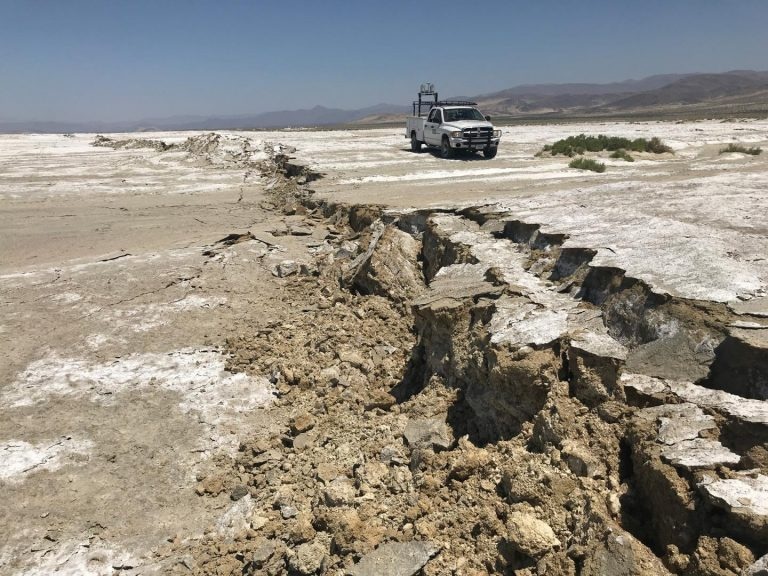Dec 5 2019
Minute internal flaws can be found in each hair-thin glass fiber in a buried fiber optic cable—and that is a good thing for researchers seeking new ways to gather seismic data in places ranging from a busy urban downtown to a remote glacier.
 Zhan and colleagues deployed a DAS system after a pair of large earthquakes that struck near Ridgecrest, California. Image Credit: Ben Brooks/USGS.
Zhan and colleagues deployed a DAS system after a pair of large earthquakes that struck near Ridgecrest, California. Image Credit: Ben Brooks/USGS.
In Seismological Research Letters, California Institute of Technology seismologist Zhongwen Zhan talks about an increasing interest in this technique—known as Distributed Acoustic Sensing—and its probable applications. His study is part of the journal’s Emerging Topics series, wherein authors are welcomed by SRL editors to look for developments that are influencing different areas of seismology and earthquake science.
DAS functions by using the minute internal flaws of a long optical fiber as thousands of seismic sensors spread through tens of kilometers of fiber optic cable. An instrument at one end transmits laser pulses down a cable, and gathers and measures the “echo” of each pulse after it is reflected by the internal fiber flaws.
When the fiber is upset by variations in strain, temperature, or vibrations—due to seismic waves, for example—there are variations in the frequency, size, and phase of laser light scattered back to the DAS instrument. Seismologists can use these variations to establish the kinds of seismic waves that might have disturbed the fiber, even if merely by a few tens of nanometers.
The sensitivity of DAS instruments has enhanced noticeably in the last five years, paving the way to new possibilities for their utilization.
The sensitivity is getting better and better, to the point that a few years ago that if you compare the waveforms from a fiber section with a geophone, they look very similar to each other.
Zhongwen Zhan, Seismologist, California Institute of Technology
Due to their performance, they can be ideally used in a range of environments, particularly in places where it would be very costly to install a more sensitive or dense seismic network. Scientists can also utilize the large quantities of unused or “dark” fiber that has been set up earlier by telecommunication companies and others. According to Zhan, a few strands off a larger cable would be enough for a seismologist’s purposes.
Zhan said the oil and gas sector has been one of the biggest promoters of the new technique, as they used cable down boreholes to track fluid variations in deep-water oil fields and during hydraulic fracturing and wastewater injection.
DAS scientists consider that the technique is particularly favorable for seismic monitoring in extreme environments, such as Antarctica—or the moon. With a standard network of seismometers, researchers “need to protect and power each node” of instruments in the network, explained Zhan. “Where for DAS, you lay down one long strand of fiber, which is fairly sturdy, and all your sensitive instruments are only at one end of the fiber.”
“You can imagine that on the moon or some other planet, with a high radiation or high temperature scenario, the electronics might not survive that long in that environment,” he added. “But fiber can.”
Researchers are already using DAS to investigate thawing and freezing cycles in permafrost and on glaciers, to properly characterize their dynamic motion of ice flows and sliding on bedrock. This could help scientists gather more information about how glacial melt triggered by climate change adds to sea-level rise.
Presently, the range of a majority of the DAS systems is 10 to 20 km. In the near future, scientists intend to extend this to 100 km, stated Zhan, which could be beneficial for seismic coverage in ocean bottom settings, including offshore subduction zones.
DAS is also ideal for fast response after earthquakes, particularly in areas where dark fiber is plentiful and seismologists have taken measures to use the fiber in advance. After southern California’s Ridgecrest earthquakes in 2019, for instance, Zhan and his colleagues went quickly to track the aftershock sequence in the area using DAS.
We turned about 50 kilometers of cable into more than 6,000 sensors in three days.
Zhongwen Zhan, Seismologist, California Institute of Technology
According to Zhan, if seismologists have done their research in detecting and requesting access to fibers in advance, a DAS system can be set up in a matter of a few hours following an earthquake.
One obstacle in using fiber is being aware of exactly how it lies in the ground. With the DAS technique, scientists know how far along a fiber a specific sensor lies. However, if the fiber optic cable is bent, coiled, or sagging, the calculations could be incorrect.
To sort this, seismologists occasionally conduct a “tap test”—which involves mapping sledgehammer blows along the ground above the cable with GPS, as the blows reverberate off the fiber to form a kind of sonar image of its twists and turns.
DAS sensors also have more “self-noise”—background seismic signals that could hinder the identification of an earthquake—than conventional seismic sensors, “but frankly we don’t exactly know why,” said Zhan.
A part of the noise might originate from the probing laser pulses, which might not be stable, or from the cable itself. A few cables lie freely in their tunnels, and others have numerous fiber connectors, which might create reflection and loss of the light signal.
While still in its infancy, DAS already has shown itself as the working heart—or perhaps eardrums—of a valuable new seismic listening tool.
Zhongwen Zhan, Seismologist, California Institute of Technology